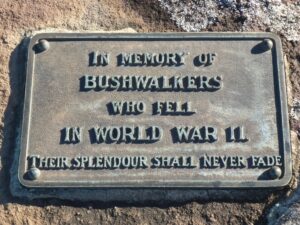No, its not a fallen bushwalker overlooked just after WWII but one of a remarkable group of Australians that should be better known.
All overnight bushwalkers should camp at least once on top of dry Mt Dingo (in the Wild Dogs of the Megalong Valley) near its southern end on 24 April for an early start. From around 5.30am onwards they will hear the tramp of feet as bushwalkers gather for the 6am Dawn Service at Splendour Rock.
Splendour Rock was a special place even before it was dedicated as a bushwalkers war memorial on ANZAC Day 1948. The plaque is on a small rock island in what surely must be a bushwalkers cathedral. There is no stained-glass window but an amazing view of the southern Blue Mountains. Mountains just disappear into the distance bounded in the east by King’s Tableland and to the west by Kanangra Walls and the High Gangerangs of Mt Cloudmaker.
In a moving but simple service thirteen (13) bushwalkers who died on active service in WWII are remembered. With luck you will greeted by an amazing sunrise as the red dawn spreads out from King’s Tableland.
In February 2023 Michael Keats and I released a book “Splendour Rock – A Bushwalkers War Memorial” that documents these bushwalkers but also four other plaques at Splendour Rock available through www.bushexplorers.com.au
The History pages of Bushwalking NSW holds a page on Splendour Rock where you will find answers to obvious questions such as who were the fallen plus some details on the other four plaques in the immediate area.
But who were the bushwalkers who served and returned from WWII? I am quietly pleased to have prepared a list for the book from available resources of 191 bushwalkers (including the thirteen fallen) since I could not find a list.
One name appeared frequently in a major resource as a POW correspondent – Bill Cawood. Each month during WWII in the Sydney Bush Walker magazine there was a section “Letters from the Lads and Lasses” where young men and women in uniform from any bushwalking club were listed.
Now, I often read books about the edges of WWII such as a recent library loan of how the French hid the Mona Lisa and other art works from the Nazis who were known art thieves. Or a book about the 2/5 AGH – “Proudly We Served”. An essential part of an army must a hospital based close to the front line such as an Australian General Hospital – AGH.
One group of remarkable unarmed Australian servicemen accepted becoming POWs. A desperate attempt to slow the German Army in Greece and Crete led to evacuation under fire via warship. The female nursing staff of the 2/5 AGH were evacuated while a core of doctors and support staff stayed behind to care for injured Australian servicemen. Their story is one of survival as they moved from prison camp to prison camp as they continued to care for those around them with limited bandages etc. Later, it was desperate times as all sorts of starving people were on the move in various directions as armies closed in on a war-torn Germany during winter of 1945. During this time the 2/5 AGH continued to assist those around them.
Previously I have never seen a bushwalker mentioned by name in a book unrelated to bushwalking but one man of this remarkable group of medical staff, is mentioned by name – Bill Cawood. Thus, Sydney Bush Walkers should be very proud of an Australian who served in WWII with great distinction as an unarmed serviceman.
Hence when you reflect at Splendour Rock on the thirteen bushwalkers who did not return from WWII also remember an unarmed bushwalker who showed great care for his mates and others around him – Bill Cawood.
Keith Maxwell.

The Splendour Rock plaque from 1948.

Comments are closed.